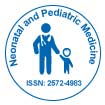Neonatal Cholestasis: A Critical Condition in Newborn Liver Health
Received: 03-Feb-2025 / Manuscript No. nnp-25-171025 / Editor assigned: 06-Feb-2025 / PreQC No. nnp-25-171025 / Reviewed: 18-Feb-2025 / QC No. nnp-25-171025 / Revised: 22-Feb-2025 / Manuscript No. nnp-25-171025 / Published Date: 28-Feb-2025 DOI: 10.4172/2572-4983.1000510
Introduction
Neonatal cholestasis is a serious condition in which bile flow from the liver to the intestine is reduced or blocked during the neonatal period. Bile is essential for digesting fats and eliminating waste products such as bilirubin; when its flow is impaired, toxic substances accumulate in the body. This condition is typically suspected when a newborn develops prolonged jaundice lasting more than two weeks, accompanied by pale stools and dark urine. Neonatal cholestasis is not a disease itself but a manifestation of underlying liver or biliary tract disorders. Early recognition, diagnosis, and treatment are crucial, as delayed intervention can lead to severe liver damage or even liver failure [1].
Discussion
The causes of neonatal cholestasis are diverse and can be broadly categorized into obstructive and non-obstructive forms. Among obstructive causes, biliary atresia is the most serious and common, where bile ducts are absent or blocked, preventing bile from leaving the liver. If left untreated, it rapidly progresses to cirrhosis and liver failure. Other obstructive causes include choledochal cysts and gallstones. Non-obstructive causes include genetic and metabolic disorders such as alpha-1 antitrypsin deficiency, progressive familial intrahepatic cholestasis, and galactosemia, as well as infections like cytomegalovirus or sepsis that affect liver function [2].
Clinical features of neonatal cholestasis go beyond jaundice. Parents often notice acholic (pale) stools, which indicate absent bile in the intestines, and dark urine, caused by excess bilirubin excretion. Infants may also show poor weight gain, irritability, or signs of fat malabsorption, such as greasy stools. On physical examination, hepatomegaly (enlarged liver) and sometimes splenomegaly may be present [3], [4].
Diagnosis of neonatal cholestasis requires a systematic approach. Blood tests measure liver enzymes, bilirubin levels, and clotting function. Imaging studies, such as abdominal ultrasound or hepatobiliary scintigraphy, help detect structural abnormalities. In some cases, a liver biopsy is needed to confirm the diagnosis and distinguish between biliary atresia and other liver disorders. Genetic and metabolic testing may also be indicated to identify hereditary conditions [5], [6].
Management of neonatal cholestasis depends on the underlying cause. For biliary atresia, surgical intervention with the Kasai portoenterostomy is the treatment of choice and is most effective if performed within the first two months of life [7]-[10].
Conclusion
Neonatal cholestasis is a critical indicator of underlying liver or biliary disease in newborns and requires urgent medical evaluation. While causes range from structural blockages like biliary atresia to metabolic and genetic conditions, timely diagnosis is essential to guide treatment and prevent long-term complications. Recognizing early signs such as prolonged jaundice, pale stools, and dark urine is vital for parents and healthcare providers alike. With early detection, appropriate medical or surgical intervention, and supportive care, many infants with neonatal cholestasis can achieve better health outcomes. Ultimately, heightened awareness and prompt management are key to reducing the burden of this potentially life-threatening condition.
References
- Grignon A, Filion R, Filiatrault D, Robitaille P, Homsy Y, et al. (1986) Urinary tract dilatation in utero: classification and clinical applications. Radiol 160: 645-647.
- Ocheke IE, Antwi S, Gajjar P, McCulloch MI, Nourse P (2014) Pelvi-ureteric junction obstruction at Red Cross Children’s Hospital, Cape Town:a six year review. Arab J Nephrol Transplant 7: 33-36.
- Capello SA, Kogan BA, Giorgi LJ Kaufman RP. Prenatal ultrasound has led to earlier detection and repair of ureteropelvic junction obstruction. J Urol (2005) 174: 1425-1428.
- Johnston JH, Evans JP, Glassberg KI, Shapiro SR (1977) Pelvic hydronephrosis in children: a review of 219 personal cases. J Urol 117: 97-101.
- Williams DI, Kenawi MM (1976) The prognosis of pelviureteric obstruction in childhood: a review of 190 cases. Eur Urol 2: 57-63.
- Lebowitz RL, Griscom NT (1977) Neonatal hydronephrosis: 146 cases. Radiol Clin North Am 15: 49-59.
- Hubertus J, Plieninger S, Martinovic V, Heinrich M, Schuster T, et al. (2013) Children and adolescents with ureteropelvic junction obstruction: is an additional voiding cystourethrogram necessary? Results of a multicenter study. Wor J Urol 31: 683-687.
- Swenson DW, Darge K, Ziniel SI, Chow JS (2015) Characterizing upper urinary tract dilation on ultrasound: a survey of North American pediatric radiologists’ practices. Pediatr Radiol 45: 686-694.
- Hussain, Walid A, Jeremy D (2019) Approaches to Noninvasive Respiratory Support in Preterm Infants: From CPAP to NAVA. NeoReviews 20:213–221.
- Bordessoule, Alice (2012) Neurally Adjusted Ventilatory Assist Improves Patient–Ventilator Interaction in Infants as Compared with Conventional Ventilation. Pedia Res 72:194–202.
Citation: Cristina M (2025) Neonatal Cholestasis: A Critical Condition in Newborn Liver Health. Neonat Pediatr Med 11: 510. DOI: 10.4172/2572-4983.1000510
Copyright: © 2025 Cristina M. This is an open-access article distributed under the terms of the Creative Commons Attribution License, which permits unrestricted use, distribution, and reproduction in any medium, provided the original author and source are credited.
Select your language of interest to view the total content in your interested language
Share This Article
Recommended Journals
Open Access Journals
Article Tools
Article Usage
- Total views: 61
- [From(publication date): 0-0 - Oct 11, 2025]
- Breakdown by view type
- HTML page views: 39
- PDF downloads: 22
